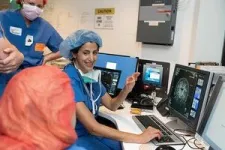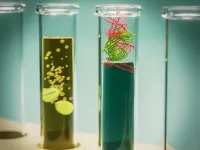(Press-News.org) Increased skin cancer screening in individuals with skin of color is not sufficient to address racial disparities in melanoma survival rates, according to a new JAMA Dermatology study by UPMC and University of Pittsburgh researchers.
Melanoma causes the most deaths of any skin cancer, but is usually treatable if caught early. Although the disease is most common in white individuals, survival odds are worse in people with darker skin tones.
“In this study, we asked whether screening could address this disparity by helping detect melanoma early,” said senior author Laura Ferris, M.D., Ph.D., dermatologist at UPMC and professor of dermatology at the Pitt School of Medicine. “Our findings suggest that regular skin checks are not the answer, but that doesn’t mean that we should be offering less care or that our work is done. We need to investigate other approaches to improve outcomes for melanoma in patients with skin of color.”
Ferris and her team analyzed data from 60,680 patients who self-reported as Hispanic, Alaska Native, American Indian, Asian, Black or Pacific Islander. 12,738 were screened for skin cancer, and 47,942 were not screened.
During the 5-year study period, only eight melanomas were detected in this population, and just one of these was identified during a screening visit. Four were identified by health care professionals during other types of visits and three were detected by the patient or a family member.
The results suggest that to detect one melanoma case in racial and ethnic minority populations, more than 12,000 screenings need to be done. For comparison, the number needed to screen in white patients is 373, the researchers found in an earlier study.
“This is an almost unfathomable number of doctor’s visits to find one melanoma,” said Ferris. “Rather than screening everyone, educating physicians about presentation of melanoma in skin of color, educating the public about their risk of melanoma and making sure that people have access to a dermatogist when they have a suspicious lesion could be more effective in improving early detection.”
While people often think of melanomas as being sun-induced, not all forms of the disease are caused by sun exposure. Certain types of melanomas can arise on the palms of the hand, soles of the feet and places that are always covered by clothes, and these tend to be more common in people with darker skin.
“UV exposure is the biggest modifiable risk factor for melanoma, so sun protection is incredibly important, but it’s not the only factor,” said Ferris. “If you have a suspicious lesion somewhere that is always covered by a shirt, it could still be melanoma. We encourage patients to seek care regardless of their perceived risk.”
Beyond early detection, better treatments for melanoma could also help address disparities in survival rates, Ferris said. Most of the current therapies for the disease were tested in non-diverse, mostly white populations, so it’s important that future clinical trials include diverse participants.
This work was supported by the University of Pittsburgh Melanoma and Skin Cancer Program SPORE P50 CA254865-01A1.
Additional authors of the study were Brandon Smith, B.A., of Drexel University; and Martha Matsumoto, M.D., Hong Wang, Ph.D., Monica Baskin, Ph.D., and John Kirkwood, M.D., all of UPMC or Pitt.
END
Screening won’t solve racial disparities in melanoma outcomes, study suggests
2023-07-26
ELSE PRESS RELEASES FROM THIS DATE:
Petrified trees reveal Yellowstone geyser’s ongoing battle with drought
2023-07-26
American Geophysical Union
25 July 2023
AGU Release No. 23-29
For Immediate Release
This press release and accompanying multimedia are available online at:
https://news.agu.org/press-release/petrified-trees-reveal-yellowstone-geysers-ongoing-battle-with-drought/
AGU press contact:
Liza Lester, +1 (202) 777-7494, news@agu.org (UTC-4 hours)
Contact information for the researchers:
Shaul Hurwitz, U.S. Geological Survey, shaulh@usgs.gov (UTC-7 hours)
WASHINGTON — Yellowstone’s Steamboat Geyser has had decades-long dry spells brought on by a history of droughts, a new study finds. With global temperatures on the rise, the American West is projected to become drier. ...
Lab on a chip technologies to improve the assessment of stored red blood cells
2023-07-26
https://www.massgeneral.org/news/research-spotlight/lab-on-chip-technology-red-blood-cellsZiya Isiksacan, PhD, a research fellow in the Center for Engineering in Medicine and Surgery (CEMS) is the lead author, and Osman Berk Usta, PhD, an investigator in the CEMS at Massachusetts General Hospital and an associate professor of Surgery at Harvard Medical School, is the senior author of a new study published in PNAS, Assessment of Stored Red Blood Cells Through Lab-on-a-Chip Technologies for Precision Transfusion Medicine.
The article is a collaboration between multiple international institutes ...
Breakthrough in solid-state storage innovates how biological materials are stored and handled
2023-07-26
Scientists have developed a novel method for storing biological materials such as RNA and proteins in a solid-state. The storage in solid-state resembles the form of a pill or a tablet, which dissolves in water for on-demand use. The innovation provides a new way to overcome current limitations in the storage and handling of products derived from living cells used for a variety of health care and scientific research purposes.
Biological materials that are frequently used in developing new medicines and diagnostic testing tools such as mRNA, enzymes, and antibodies are highly ...
In search of electromagnetic counterparts of gravitational waves
2023-07-26
Alessandra Corsi knows that when you shoot for the stars, anything can happen.
It’s in that spirit of intellectual curiosity that Corsi, an associate professor in Texas Tech University’s Department of Physics and Astronomy, will peer into some of the farthest recesses of space in search of gravitational waves.
“We are at a critical moment in this field,” she said. “We had one event in 2017 that was amazing where everyone in multi-messenger astronomy started caring more about gravitational wave data, but now we need more of those type of events so we can study them and understand them better.”
Corsi has received a three-year grant from the ...
New approach to fuel cell manufacturing could reduce cost, increase availability
2023-07-26
UNIVERSITY PARK, Pa. — A Penn State-led team of researchers developed a potentially promising approach to make fuel cells more affordable. The new method reduces the amount of platinum-group metal (PGM) loadings by replicating a process used in computer chip manufacturing.
They published their results this week (July 24) in JACS Au, an open-access journal of the American Chemical Society.
According to corresponding author Christopher Arges, an associate professor in the Department of Chemical Engineering and a faculty member in the Institutes ...
Study examines struggles of Haitian migrants self-managing diabetes on Dominican Republic sugar cane fields
2023-07-26
COLUMBIA, Mo. -- A new study from the University of Missouri Sinclair School of Nursing found that barriers, including poverty, low health literacy, cultural beliefs, lack of infrastructure and political issues, all work together to hinder diabetes self-management for Haitian migrants working in sugar cane fields in the Dominican Republic.
Rosalia Molina, a nurse who has taken previous medical missionary trips to the Dominican Republic to help impoverished individuals self-manage their diabetes, led the study as part of her doctoral studies at the MU Sinclair School of Nursing. She interviewed health care workers in the Dominican Republic about their challenges providing ...
Scientist discover protein required for an effective immune response to invading bacteria
2023-07-26
Key Takeaways
Researchers have discovered that the NLRP11 protein plays critical roles in alerting the body to a bacterial infection and initiating an immune response against it
NLRP11 is present in humans and other primates but absent in mice
The discovery could enable the development of mouse models that are more similar to humans for bacterial infection experiments
BOSTON – A team led by researchers at Massachusetts General Hospital (MGH) has discovered a protein that plays critical roles in alerting the body to a bacterial ...
People with increased genetic risk of Alzheimer’s may lose sense of smell first
2023-07-26
MINNEAPOLIS – People who carry the gene variant associated with the strongest risk for Alzheimer’s disease may lose their ability to detect odors earlier than people who do not carry the gene variant, which may be an early sign of future memory and thinking problems, according to a study published in the July 26, 2023, online issue of Neurology®, the medical journal of the American Academy of Neurology. The gene variant associated with this increased risk of Alzheimer’s is called APOE e4.
“Testing a person’s ability to detect odors may be a useful way to predict future problems with cognition,” said study ...
RIT professor co-authors paper on new planetary formation findings
2023-07-26
Rochester Institute of Technology’s Joel Kastner, a professor in the Chester F. Carlson Center for Imaging Science and School of Physics and Astronomy, and a team of researchers with the European Southern Observatory (ESO) have discovered new evidence of how planets as massive as Jupiter can form, using images from the ESO’s Very Large Telescope (VLT) and the Atacama Large Millimeter/submillimeter Array (ALMA).
The combination of VLT and ALMA imaging have yielded detections of dusty ...
Delaying methane mitigation increases risk of breaching Paris Agreement climate goal, study finds
2023-07-26
A new study by Simon Fraser University researchers shows that efforts to reduce methane emissions are needed immediately if we are to meet global climate change goals.
A key element of the 2015 Paris Agreement, a legally binding international treaty on climate change, is the commitment to limit average global temperatures increases to well below 2°C above pre-industrial levels, and pursue efforts to limit global warming to 1.5°C above pre-industrial levels. This requires reaching net-zero CO2 emissions by or around 2050—and deep reductions in methane and other ...





